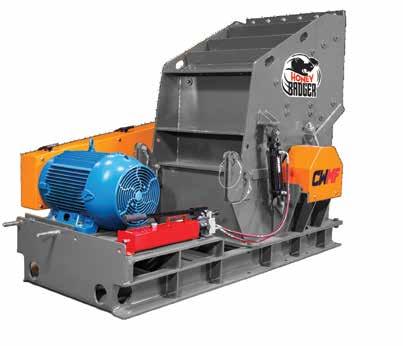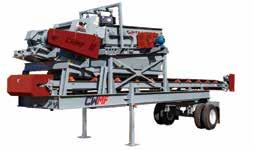
5 minute read
Hawaii Preserves for Perpetuity
DDifferent states use different pavement preservation and maintenance methods to maximize their paving budgets. While department of transportation (DOT) materials specifiers and pavement managers alike know the importance of pouncing on the right pavement with the right treatment at the right time, funding coffers ultimately dictate what can be done and when.
In Hawaii, the Hawaii DOT (HDOT) recommends mill-and-fill and crack fill maintenance procedures, but the different counties along the island chain have regional and weather-induced needs influencing their funding reservoirs. Hawaii Asphalt Pavement Industry (HAPI) Executive Director Jon Young discussed the pavement treatments used in Hawaii during a HAPI Shorts, Lunch Time Lessons webinar.
The County of Hawaii performs overlays in addition to mill-and-fills with the three pavers owned by the agency.
Since 2016, the County of Kauai has been using a sealcoat as its pavement treatment.
The County of Maui’s approach to pavement preservation is to perform crack filling, and to lean heavily on slurry seal and micro surfacing treatments.
The City and County of Honolulu (City) also perform mostly slurry seal and seal coat treatments, and do so in a manner that returns the roads to traffic by 3:30 p.m.
Oahu has embarked on a robust pothole patching program. They use the throw-andgo approach as this method allows them to quickly repair potholes. Look at these stats. • In 2008, Oahu repaired 82,850 potholes • In 2010: 41,805 potholes • In 2012: 52,070 potholes • In 2014: 39,951 potholes • In 2016: 42,656 potholes • In 2018: 20,987 potholes • In 2020: 11,711 potholes
The decrease in potholes can be attributed to the city’s repaving program and their maintenance of the roads using pavement treatments. In 2012, HAPI members welcomed then Mayor Peter Carlisle and joined the Department of Facility Maintenance to demonstrate four pavement preservation methods the city would evaluate as part of its effort to improve road conditions. Over 120 guests from city, state and federal government agencies, as well as contractors and consulting firms, attended the demonstration to observe the application of the four treatments. We demonstrated crack filling, a fog seal, a sealcoat and a slurry seal. The demonstration areas were then monitored by the city to evaluate how the various treatments perform under local weather conditions, especially Hawaii’s high level of ultra-violet radiation.
Then in 2014, HAPI members donated labor, material and equipment to pavement treatment research being done by our University of Hawaii.
The counties and agencies use various pavement management systems to assess whether the preferred treatment regimen is the best option. For example, the County of Maui uses iWorQ, which offers a subjective pavement distress rating system based on what the engineer sees happening with regard to fatigue, transverse, longitudinal, patching and/or edge cracking. The engineer scores or rates the distress according to the extent of the cracking segment (low to high) and the severity of distress (low to high). (See the table at right.)
In the event a pavement has a low enough score, an agency that typically depends on a sealcoat knows this process is merely burning money for the season. Members of HAPI who perform maintenance work have the opportunity to reach out to agencies and recommend robust methods that will target and correct pavement system troubles from the bottom-up, prior to performing the preservation treatments that seal and protect from the top-down, but this is a rare occurrence. The agencies are the parties that determine the treatments they have the funding for.
Deep maintenance and preservation tagteam can be avoided with perpetual pavement planning. Light maintenance and preservation tag-team can be a smart, infrequent method of protecting a long-lasting pavement that’s been designed for permanence.
When a team designs in long-lasting performance, the asphalt roadway can last 35, 65, 95 years and up with minimal structural improvements during its life. In fact, the Asphalt Pavement Alliance (APA) has built its Perpetual Pavement Award on that concept. The awards started in 2010 and now have over 150 winners; award-winning pavements achieved through conservative designs.
The cost savings for an agency are obvious.
Any long-lasting pavement system requires only infrequent maintenance or surface preservation for it to remain long-lasting. Like a deck requires a fresh coat of paint every few years to protect its wooden planks from the sun, a 35-year-old road requires a check-up once in a while to make sure the elements aren’t causing harm.
To win a Perpetual Pavement Award, the system must meet the following criteria: • have 35+ years of service; • experience minimal structural improvements totaling less than 4 inches of gain; • incur infrequent resurfacing; and • show no deep structural distress.
This means a 45-year-old pavement that needs a mill-and-fill to correct some freezethaw cracking could have 2 inches of depth milled, a 2-inch lift replaced, a sealcoat sprayed on top the next summer, and have gained only a smooth new ride for the taxpayers. That’s a minimal maintenance and preservation investment on a long-lasting, award-winning roadway.
At this time, Hawaii has not yet designed any perpetual pavements. HDOT has recently designed a road with a 50-year service life and, since 2007, new city streets pavement sections are like a perpetual pavement design.
– BY SANDY LENDER AND JON YOUNG
PAVEMENT DISTRESS RATING
Extent of Segment
0 LOW MED HIGH
SEVERITY OF DISTRESS LOW 1 2 3
MED 4 5 6
HIGH 7 8 9
For more information on how to select minimally invasive maintenance treatments, visit the Treatment Toolbox tab at https://roadresource.org/.
CRUSH RAP COSTS
with the HONEY BADGER
From replaceable abrasion-resistant steel wear liners to a 1/2" steel pulverizing hopper, this machine is ready for wear and tear. And by reducing material handling and minimizing moisture, the Honey Badger increases production and saves on fuel costs. Average return on investment is 1/8 the cost of other crushing operations. Fully-equipped with max power, reliable operation, and easy maintenance, the Honey Badger is ready to crush your costs!
Reduced RAP moisture = lower fuel consumptions

Reduce or eliminate crushing costs
Typical 6 month ROI
(300,000 ton/season plant)
Minimize material handling
STATIONARY PORTABLE










